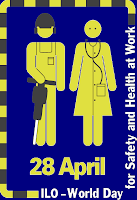«A primeira cerimónia teve lugar em 1996, em Nova Iorque, na Organização das Nações Unidas, onde foi aceso um memorial para recordar todos aqueles que perderam a vida enquanto trabalhavam ou que contraíram doenças relacionadas com a sua actividade profissional. Com esta primeira Jornada de Luto estava consagrado o Dia Internacional de Luto pelas Vítimas de Acidentes de Trabalho e Doenças Profissionais.
A data foi escolhida para coincidir com as Jornadas Nacionais de Luto do 28 de Abril, previamente adoptadas pelo Congresso Canadiano do Trabalho, e logo se disseminou por todos os continentes, por iniciativa de diversas organizações sindicais.
Em 2001 esta comemoração foi reconhecida e apoiada pela Organização Internacional do Trabalho (OIT) [link: Escritório da OIT em Lisboa] e, actualmente, é celebrada oficialmente em inúmeros países.»
É também neste dia que, em Portugal, se comemora o Dia Nacional da Prevenção e Segurança no Trabalho, instituido pela Resolução da Assembleia da República n.º 44/2001.
Mais informações no sítio da internet do ex-Instituto para a Segurança, Higiene e Saúde no Trabalho, na secção de notícias e no sítio da OIT (World Day for Safety and Health at Work: 28 April 2008).
No sítio da Autoridade para as Condições do Trabalho poderão aceder a informações alusivas ao Seminário “Dia Nacional de Prevenção e Segurança no Trabalho”, promovido pelo Estado-Maior da Força Aérea e claramente direccionado para os militares da força aérea. Consultem o programa do evento aqui.






